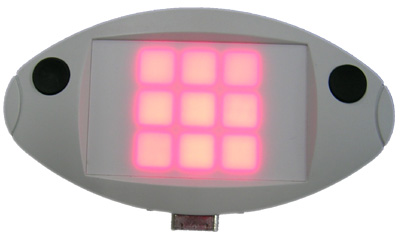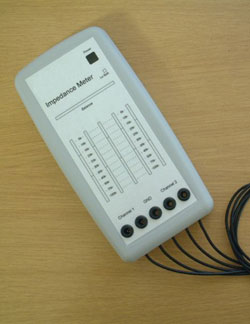Winter Brain Conference
by Siegfried Othmer | February 3rd, 2005We are once again at the threshold of the Winter Brain Conference. Preliminary conferences are already going on. This year will mark the entry of EEG Support into the hardware business. With the help of a few gnomes of Zurich we have developed a QIKtest device that allows us to run a variety of choice reaction time tests like the CPTs we are used to. Just working through the development process has been liberating to our thinking. There has been controversy among users about just how fast progress in TOVA terms can be made with various techniques. We’ve been reluctant to subject people to a lot of such tests because they are such an imposition on people. Now we have a choice.
 The QIKtest
The QIKtest
The new device has nine LED fields in a 3×3 array, and a left and right button for responding. Auditory challenges are available as well. Any combination of LEDs can be used to represent the “go” or “no-go” condition. The tests can be down-loaded through a serial connection from the clinician’s computer to the device. The device stores the test results internally, until they are uploaded to the computer, where the results are then displayed. The data is then uploadable to the EEG Expert website for progress tracking over sessions.
Sue has generated a number of one-minute tests in which the level of difficulty increases as the test progresses. In fact, it is difficult to believe that the test is only a minute long. These tests have no direct tie-in to the familiar TOVA or IVA, but they do give us indication of progress over sessions, and they are a challenge to the client. Reaction time is tracked, along with variability and the usual omission and commission errors. Given the brevity of the test, it is no surprise that we tend not to register a lot of omission errors. But with the rapidity of the challenges that have been dialed in, commission errors are more commonplace than with the TOVA.
The tests are a challenge for adults, and undoubtedly will overmatch young children. So future tests will need to accommodate varying ability levels. It is not intended that these tests be normed. On the contrary, one might envision a variety of challenges that a person might progress through during training. Each one will give an additional measure of progress in training. We have been trying the existing tests in the office, interspersed with neurofeedback sessions. (Sue used to beat me in table tennis. Now she routinely bests my reaction time on the QIKtest. But I am making progress…)
We are also implementing full CPT tests on the unit. There has to be some pre-testing first before we commit to a final design that will then be normed. So this is of necessity a slightly lengthier process. We would like the test to be close to what people are used to from the TOVA and the IVA, but we also want to move forward. We will either alter or drop the 200msec criterion for anticipatory responses because it is clearly arbitrary and inappropriate. We also intend to handle the auditory challenges differently.
The auditory TOVA has not caught on very well, and so potentially significant information is being missed. I would argue that the auditory TOVA largely differs from the visual in terms of reaction time and variability, not so much in terms of omission and commission errors. If that is the case, then one does not need to complement a visual CPT with a full auditory CPT. It would be sufficient to do a brief auditory test to see how much slower the auditory reaction time is, and how much greater the variability. So for most people the combination of a visual CPT plus a brief auditory challenge should be sufficient to characterize them.
We have appealed to the TOVA folks for lo these many years to give us some additional capabilities, not to mention getting past the DOS operating system and dot matrix printers. Since their addition of the auditory test, not much appears to have happened. So we have finally had to strike out on our own to solve these problems. One of the features that we have wanted from TOVA is a time marker to indicate precisely when the stimulus is being presented. That could then be used to index a QEEG record, for the subsequent off-line evaluation of evoked responses. The QIKtest unit includes this feature.
We expect that home users may want the unit as well, in order to track progress at home, and perhaps to help establish a good training interval for those who are suffering cognitive decline.
 Impedance Meter
Impedance Meter
Did anyone on the list ever think we would not only be recommending an impedance meter, but would actually be building one? Again with the help of the gnomes of Zurich, we have developed an impedance meter that actually fulfills the purpose. The problem with conventional impedance meters is that they are used in a one-time measurement when in fact we are often contending with wiggly kids whose contact impedance may change during the session. So an in-line measurement is needed. On the other hand, incorporating an impedance measurement that does not impinge on the signal at all is rather a challenge. The solution is to have an in-line impedance meter that is engaged with a button push, and that is essentially out of the circuit otherwise. The unit connects directly to the BrainMaster or NeuroCybernetics amplifier, and the electrodes are plugged into the impedance meter, where they remain throughout the session. The meter is simply “parked” on top of the BrainMaster amp or the NC amp, or next to a procomp.
The other significant feature of the impedance meter is that it allows a direct comparison between the two “legs” of the circuit, the two active leads, with respect to their contact impedance. This is because what matters almost more than the impedance itself is the match between the two. Low contact impedance is one assured way of minimizing the difference between the two legs, but if we merely guarantee a match, then our tolerance for contact impedance is relaxed considerably. The underlying issue is “common-mode rejection,” the ability of the differential circuit to suppress signals that are common to both legs. To assure maximum common-mode rejection, both arms or legs of the circuit should be electrically identical. So, balance is what matters. The new unit has a display for the balance in resistance between the two active electrodes, so one can tell at a glance if a problem exists.
Where this unit comes in handy is whenever there is a mystery at the beginning of a session as to whether the signal you are seeing is real. Whenever there is a problem, or a suspected problem, one generally simply reworks the contacts to see what difference that makes. Such goings-on may be less than reassuring to a new client. With the impedance meter installed, a simple button-push will reveal whether there is a potential problem, and if there is, which electrode should be worked on to improve it.
Web-based training
We are also launching the web-based training at this conference, with the release of Sue’s decision tree. As an alternative it will also be available on CD. A translation into Spanish is underway. We expect this offering will be useful to people who have not attended the advanced training course for a while, as well as for practitioners of other persuasions who simply want to gain an acquaintance with our approach. It can also serve as a refresher to those who have taken the initial training course in the past couple of years. To be launched shortly is our Alpha/Theta module.
Attendees at the conference are invited to a get-together Friday evening where we will meet and discuss EEG Expert and QIK test assessment.
This entry was posted on Thursday, February 3rd, 2005 at 5:40 pm and is filed under Conferences. You can follow any responses to this entry through the RSS 2.0 feed. You can leave a response, or trackback from your own site.





